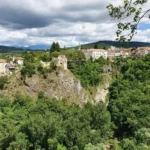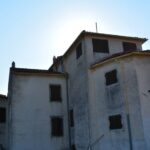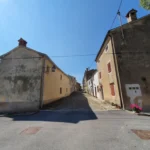High above the Mirna River valley, where oak forests hide the most treasured truffles of Istria, Buzet rises in calm dignity. The town is not only known for its abundance of this rare delicacy, but also for the quiet craft that lingers in its streets — old workshops, stone houses, and the gentle rhythm of a place where time still follows slower measures. To wander here is to feel both the earth’s richness and the enduring magic of human hands.
Buzet is a quaint town located above the valley of the river Mirna in northern Istria. It does not coincidental recognized as one of the Istrian places known by Truffles. Lonely in the middle of the valley, ancient Buzet located on a hill (158 m) reveals many things, historical and cultural. The historians used to call it “The Key of Istria”. A small town illuminated by the first rays of the morning sun reveals a unique reflection of its ancient and millennial past. On the other hand, once one steps in, this town would reveal magnificent views. They stretch to the landscape of northern Istria, bordered by forests, the magical valley of the river Mirna, which is constantly flowing, like time passing. Buzet is picturesque but probably the most known for the festival “Subotina po Starinski”.
Travelling northern Istria: B means Buzet…the tiny town of the medieval heritage
Couples, mountaineers after the Ćićarija hike, photographers and families with children will find a walkthrough Buzet. Although it was first mentioned in 1102 when the Istrian Marquis Ulrich II. donated to the Patriarchs of Aquileia, the historical roots of the picturesque town rest on the foundations of a prehistoric hillfort. It is considered one of the oldest formations in Istria. During the Bronze Age, the area was inhabited by Illyrian tribes.
The Venetian Republic heritage
The picturesque town provides a pleasant climate to visit throughout the year, from spring to winter. Even today we can feel the spirit of the legacy built by the Venetian Republic, during the 16th century. After Aquileia handed over Buzet to Venice in 1421, the fortress of Rašpor was destroyed. Until then it was then the seat of the Venetian military governor, until 1797.
The period of Venice is also the largest part of the view of today’s place. Then crafts and defensive walls are established. And the Venetian Republic is also credited with making Buzet and the city a palace. The Bembo Palace (1728) is a classicist Venetian Baroque, the Flego Palace (16th century), originally a parish court, the stone lion’s mouth created in 1755 is part of the wall of the Bigatto Palace (1639), which today serves as a museum, De Vertis Palace 1728) is with pictures of nobles. And finally, the thing that should not be left out in Buzet are the views that spread towards the green slopes of Ćićarija, as well as the valley of the river Mirna.
Vela and Mala Vrata Gate
As once in medieval times, the city surrounded by walls is entered through the Great and Small Gates. Both date from the time of Venice: the ” Great Gate ” (1547) was built by Captain Gianmaria Contarini, and the ” Little Gate” (1592) has the coat of arms of Captain Solomon. Once you pass through the Little Gate, the old town will dazzle you with its architecture at first sight. Lovers of small towns will love to walk the mysterious streets of Buzet, under the tall green canopy of trees that hide mysterious stories. One of them will also reveal an event three centuries ago before the city entrances were formed. Namely, in 1267 Buzet was looted by the Count of Gorizia Adalbert II.
Vela and Mala Šterna cisterns
The word “Šterna“, which in the Istrian dialect refers to the cistern, is especially important for Buzet. The architectural element was built as part of a separate building next to the houses or villages for water storage. While their inner layer is treated with waterproof mortar of lime, sanded brick, quartz sand and sometimes volcanic element, the upper part is always photogenic. Buzet overlays of the late Baroque Vela Šterna, a polygonal floor plan from 1788/1789. g. with a fence made of Rococo-style decorations and the coat of arms of Captain Marc ‘Antonio Trevisano. At the foot of the inscription is a Venetian symbol, a relief of a lion. Mala Šterna dates from 1517/1522. g., and renovated in 1563.
Four squares and three streets
The arrangement of the Šotojorti and Lopar promenades (not on Rab) along with some classicist houses from the 19th century forms a small town with four squares, which connect three streets. The square with the parish church of the Assumption of Mary carved into the rock is a very unique place. The single-nave building with side chapels is late Palladian and dates from the period between 1779 and 1784. It is the work of F. Dongetti, modelled on the parish church in Umag.
An important liturgical object is the gilded silver sign from 1453. Next to the church, there is a bell tower from the 15th century with a Glagolitic bell carved in 1541. The lapidary in the southwest tower is also interesting. An element that is often found in other Istrian towns is the fonticus. In Buzet was built-in 1534. It served as a granary during the Venetian Republic. It was rebuilt in 1587, while in 1900 it was modified for social events.
Bonus: learn this particular thing in Buzet
Let’s say you decided to get more from Buzet. Here we mentioned what Buzet could offer.
Find out Buzet Earring in the city museum Buzet
Earrings found in the tombs of the native Illyrians, the so-called The Celts in northern Istria, in the cemetery in Mejica (18 specimens) and Sovinjski Brdo (2 specimens), date from the 7th and 8th centuries. They are today’s symbol of Buzet. Their originals are in the Buzet Homeland Museum, which is located in the building of the Bigatto Palace from 1639. According to archaeological literature, Buzet earrings were found mainly in the early Middle Ages in the tombs of the Adriatic and Alps. Find one of them and try it to suit your ear! The museum also provides a historical collection of medieval frescoes, Glagolitic inscriptions, ethnographic collection, crafts such as bakery, blacksmith shop, and comb making.
Uncover the legend about the name of the city of Buzet
The name Buzet or ” Blzet ” was adopted on maps and standard Croatian. We will note that the place is first mentioned under the name Piquentoi, by Ptolemy. The Celts called it Piquet, which would mean “capital”. The later Roman name is transformed into Pinguentum – Puente. The existence of this name in Roman times is proved by a plaque in honour of the goddess Augusta, who protected the then city of Pinquentum from the plague, and was built by the people of Buzet in 192 BC. From the roots of Pinguente, residents who have left the city develop the surname ” Dapinguente “. The same in translation would mean “from Buzet” (Chakavian “Buzet ”). Several similar surnames related to the place are found in Italian such as Dapiran, Damuggia, Dazara, etc.
What is most interesting is the legend about the origin of the name of the city, a folk tale that has been passed down for generations. During the harsh winter, at the time when Buzet was looted, a boy without shoes on his feet descended to the foot of the town. Seeing him, his peers start mocking him for being a ” bus “, which in translation from the Buzet dialect would mean barefoot. Since then, the semi-deserted town on the hill has been called Bus or Buz, which in the spirit of the Slavic-Croatian dialect turns it into Buzet throughout history.
Visit Subotina po Starinski Feast
With a hundred-year tradition, “Subotina Po Starinski”- “Saturday of the Old Way”, is traditionally held every September, the first Sunday after the Nativity of the Virgin Mary. It is the largest and most massive event in the Old Town of Buzet. The fair runs all weekend. It starts as early on Friday under the local name “Petkotina” (Friday fair), continues the following day as Saturday, and finishes with the final ceremony on Sunday. Subotina Event will provide all the former Buzet elements and show how Buzet looked in the Middle Ages.
To feel and expire an example of an Istrian town Buzet of the Middle Ages is a unique and unforgettable experience. All the old artist workshops that were once the most in Buzet are opened in rustic style, the streets are filled with traditional music. Something that is probably the most recognizable is crafted on Buzet streets. Stroll the medieval Buzet and look at how the old town bakery, the old blacksmith shop, the comb shop, and the old town pharmacy once looked. Traditional costumes as a symbol are characteristic of the fair.If you come to Buzet on that day, you will have the opportunity to step back in medieval times. Take a walk and meet the street performers. Old craftsmen, the traditional street instrumentalists, folk theatre participants, chimney men, firemen, ice cream makers, street entertainers, painters, or street photographers, all will wait for You. Plenty of Istrian indigenous local products sell at the fair.
Outdoor Buzet
There are numerous outdoor activities you can do around Buzet. I couldn’t still decide what my favourite is instead chosen. Hike the trail of the “Seven waterfalls” under Buzet, or Ćićarija Hills (Zbevnica, Raspadalica ridge) above it, or drive a bicycle to Pietra Pelosa Castle.So You have come and visited the Old Town of Buzet, discovered its historical features. However, you still have time to see its surroundings. Don’t wait too long. Bordered by the mountains of Ćićarija on one side, Kotli and the Mirna River, Buzet is a real paradise for outdoor sports enthusiasts. So, Let’s start.
Seven Waterfalls Trail
Yes, we did it once, and every time I finish still want to go again. The trail is 14.5 kilometres long it takes about 6 hours of walking. You’ll be made along this marvellous and beautiful trail that passes the bridges, lakes and villages alongside the Mirna River. And the most important you’ll be given near the Seven Waterfalls since the course bears their name by them. The “Path of 7 waterfalls” is one of the pearls of Buzet and today is considered one of the most beautiful tourist attractions of the area.
A circular trail is with the same starting and ending point in Buzet. However, the recommended control point I recommend to count on is the village of Kotli, since the official trail turns back to Buzet from it. I want lots of fun and relaxation for all those who decide to make this trip. Although the track is not very difficult, a couple of climbs make it more demanding, incredibly the few of them. As the entire stock is relative long, it is classified as a hiking route. Nevertheless, many beginners and tourists will find pleasure in this course. Enjoy the photography of the street.
Žbevnica Summit
Yes, we did it, and not just one. We have been doing it a few times per year as training since the Putokoza must be in good health condition. Žbevnica is considered the westernmost Croatian peak of more than a thousand meters (1014 mt). It is apart of the Ćićarija mountain range that is situated right above Buzet. Made of limestone on each side it has a large and steep forested slope. However, the lush grass rises to the top above the forest belt. The upper of the mountain is covered by beautiful green meadows.
You can make a few of the routes to Žbevnica, but this is what I recommend starting in the little village of Brest. You can easily reach Brest by driving directions to Počekaji (train station) from Buzet. By arriving in Počekaji just continue forwards by lifted mountain road. After some 10 minutes of the drive, you’ll reach Brest. Leave a vehicle in the little village of Brest and start the hiking trail here. There is Žbevnica Mountain Hut above the town of Brest. It is a point of 851 meters above sea level. The mountain affiliation “HPD Planik” members fromUmag run the hut. During the summer it should be open every weekend. From here you’ll need still about 45 minutes to reach the summit of Žbevnica.
The view from Žbevnica merely is lovely. You’ll see Buzet and the central part of Istria on one hand. Simultaneously, in the northern region on a sunny day, there will be a visible Koper harbour.
Pietra Pelosa Castle
Yes, we did it. The Pietrapelosa Castle, located amidst dense vegetation on an elevation between Buzet and Livade often is called only the Castle or Kostel. It might be an attractive location for mountain bike lovers, starting the trail Buzet.The natural way through forests and meadows of Buzet’s surroundings leads to the castle, dating back to the 10thcentury. It’s assumed the court changed several owners during history, including the Venetian Empire, but it has never been destroyed.
Find more about Buzet Trails
Sure, there are still numerous trails around Buzet including those from Roč to the Raspadilica or the cyle ride from Buzet to Istarske Toplice, an Istrian spa. After spending the whole day exploring northern Istria, sit down in some tavern and try some of the Buzet specialities with the truffles. Nothing else than pizza with sausages and truffles can be served I recommend. Take a look at Buzet’s surroundings from its hill, it looks beautiful and almost at first glance so undiscovered, doesn’t it?
- Climbing tip. Though the Ćićarija mountain range seems to be not so high and famous, it offers various activities such as climbing. There are a few climbing spots nearby Buzet and Roč that will be enjoyed by climbers. One of the lovely climbing spots is a rock in the canyon valley of Vela Draga. The canyon is made of marvellous karst geomorphological natural monuments.
- Paragliding.There is right above Buzet the favourite spot for paragliders at Raspadalica. Paraglider? Enjoy in Buzet from above!
Surrounding Buzet daily tours
Though we already mentioned some of the outdoor ideas, we listed still a few spots that might be interesting while in Buzet.
Head to Salež and see the Pillar of Shame
Salež is a small village situated between Zrenj and Motovun. The place is known for containing the only preserved pillar of shame in a human figure’s shape. The post made of white stone is also called “Berlin”, after the four-seat carriage known as Berlina which once drove between Berlin and Paris. According to legend it was used to expose offenders to public ridicule. Here’s how to get to Salež from Buzet:
- By Car. Salež is about 8,5 kilometres distant from Buzet, and it is 15 minutes of driving time.
Admire Hum – the Smallest Town in the World
Besides being famous as the smallest place globally, Hum cobblestone streets with the view extending to the central Istrian landscapes will offer a unique experience to everyone. There are two principal streets only, but everyone seeking inspiration will find something interesting. Here’s how to get toHum from Buzet:
By Car: Hum is 17 kilometres distant from Buzet, and it is 15 minutes of drive.
Visit Vipava Valley
Situated in Slovenia, the beautiful valley of Vipava (Vipavska Dolina) is full of golden greenery treasures. See the picturesque places as Ajdovščina or head up to some of the mountains above Vipava (see details in our trail section). During the warm summer days when it appears too hot, the Nanos, Gora and Trnovo Plateaus offer plenty of refreshment, alongside the crystal rivers and springs. There are beautiful huts such as Sviščaki or Vojkova koča Na Nanosu, and they are reachable by car. Getting to Vipava Valley from Buzet:
- By car: There are about 75 kilometres from Buzet to Vipava valley and the drive time lasts about one hour and a half.
Seek refreshment in Kotli
One of the most beautiful and valuable rural architectural wholes will reveal its origin yards, terraces, fireplaces, chimneys and mills. It is situated right above the Mirna River that tumbles through the village. Everyone seeking inspiration in a combination of nature and rural architecture will enjoy a tour to Kotli, which was already mentioned in the activities (see above 7 waterfalls trail).Look at the Mirna River, creating the waterfalls over the rocks and forming hollow pools carved into the stone after which the village got its name (Kotli).Getting to Kotli from Buzet:
Getting by car. It’s 15 kilometres of a drive from Kotli to Buzet, which is about 15 minutes.
Getting to Buzet
- ✈️ Air. There are several nearest airports where you can get while travelling to Buzet by plane. Pula Airport is about 90 km distant from Buzet. Rijeka Airport is located approximately 75 kilometres. Trieste Airport is about 90 kilometres distant. Venice Airport is located about 200 kilometres far away from Buzet. Zagreb Airport is distant about 220 kilometres from Buzet.
- 🚌 Bus. The bus station in Buzet is situated 600 meters from the centre. As the town is not large, it is possible to walk to any city border location. There are bus connections from almost every bigger Istrian town to Buzet, such as Umag, Novigrad, Poreč and Rovinj. There are daily bus connections to Rijeka and Zagreb and international connections to Trieste and Venice.
- 🚆 Train. The nearest train station considered to be Buzet is located in a small village of Počekaji. It’s 5 kilometres far away from Buzet.
- 🚗 Car and parking. Buzet is very vell reached via the land roads. There are several parking locations under of hilltop and one above the entrance of the town. What we suggest is the parking place under the hilltop.



